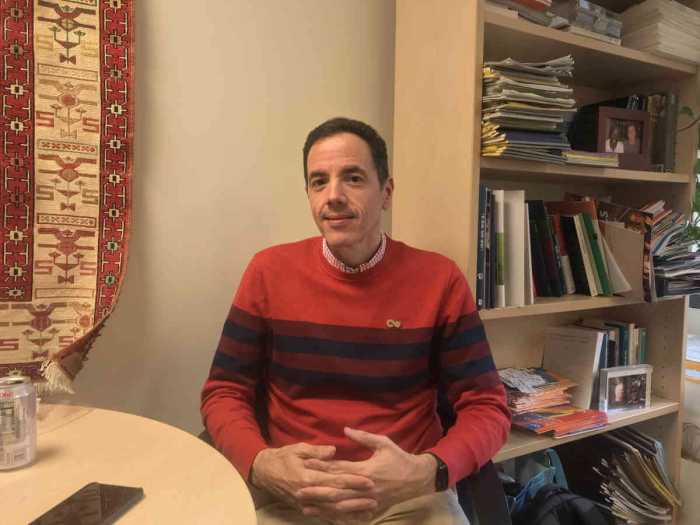Viggo Mortensen in Lisandro Alonso’s “Jauja.” | THE CINEMA GUILD
Like all great films, Argentine director Lisandro Alonso’s “Jauja” makes up its own rules. Or, at the very least, it synthesizes its influences, which seem to stretch from John Ford’s classic Westerns to Apichatpong Weerasethakul’s Buddhist surrealism, into something really new. Its elliptical narrative and refusal to answer most of the questions it raises are bound to disappoint literal-minded spectators, but I think it’s by far the most accomplished of Alonso’s films and the best new release of 2015 so far (granted, the year is very young).
Like much of Alonso’s work, “Jauja” is about a man who finds himself lost in the wilderness. (In one Alonso film, that mysterious landscape turns out to be Buenos Aires’ Cinematheque.) In theory, Alonso has taken a few steps closer to the mainstream: making a period piece and casting a Hollywood star, Viggo Mortensen. But this isn’t “Howard’s End.” Mortensen doesn’t speak a word of English in “Jauja,” and the film casts a hard glare on Argentina’s genocide of its indigenous people.
Lisandro Alonso’s “Jauja” chronicles Viggo Mortensen’s dark journey into Patagonia
“Jauja” takes place in Patagonia, Argentina during the late 1880s. Mortensen plays Captain Gunnar Dinesen, a Dane who’s working as an engineer for the Argentine army. His 15-year-old daughter, Ingeborg (Viilbjørk Mallin Agger), lives with him. In an all-male environment, she arouses much attention, despite her tender age, and a young soldier falls in love with her. They run off together. When Dinesen finds out the truth, he dashes off into the desert to find her, despite his men’s warnings about Patagonia’s dangers. These warnings turn out to be well-founded.
“Jauja” was shot in a nearly square 1.33 frame, like a pre-1953 Hollywood film. The cinematography is slightly fuzzy with rounded edges, just enough to remind us we’re watching a movie that was shot on video. At first, the landscape is gloriously green. It’s not entirely clear what time of the year “Jauja” takes place, but it seems comfortable enough for a man to leisurely pleasure himself in a hot spring. Thunder often rumbles ominously in the background, though.
Alonso’s framing contrasts action in the front and back of the scene. He’s working on a narrow screen, but he uses every inch of it, often having actors move from the foreground to the background. While Alonso’s direction seems influenced by the “festival cinema” reliance on master shots and long takes, it’s not at all rigid. Whether a shot needs to run 10 seconds or two minutes, that’s how long it lasts.
As “Jauja” progresses, its landscape seems to turn into Dinesen’s mental space. Green grows sparser, dark colors more common. The cinematography remains striking, but the spaces through which Dinesen travels aren’t the kind that would attract tourists to Patagonia. Rocks outnumber grass. The cave in which he meets an eccentric elderly woman has a vaginal slit for an entrance. Objects are passed down over centuries.
A Danish-American, Mortensen spent part of his childhood in Latin America, where he learned Spanish. He speaks both Danish, presumably learned from his family, and Spanish in “Jauja.” Mortensen has always had a chameleonic quality. As Sigmund Freud in David Cronenberg’s “A Dangerous Method,” he warned Keira Knightley’s Russian-Jewish character against the danger of trusting “Aryans” too closely. But as Dinesen, Mortensen appears to be the perfect Nordic conqueror. It’s part of the film’s plan for Dinesen to learn that Latin America can get a hold over him. One of the many co-producers of “Jauja” (and the co-composer of the two pieces of music heard during it), Mortensen gives a largely non-verbal and increasingly athletic performance in its second half. However, Alonso strips away macho pretense from acts like horseback riding and rock climbing.
If it were made in the early ‘70s, “Jauja” could have played as a midnight show for months to stoned moviegoers. Who knows what its chances of finding an audience, despite Mortensen’s presence, are now? It evokes the “acid Westerns” of post-”East Rider” America, powered equally by the collapse of the old Hollywood studio system and repulsion at the Vietnam War. These films had a short initial life, and Jim Jarmusch’s “Dead Man” is the only film of the past 20 years that picked up where they left off. Alonso takes the baton from Jarmusch. If the title weren’t already taken, “Jauja” could have been called “Let’s Get Lost.”
JAUJA | Directed by Lisandro Alonso | The Cinema Guild | In Danish and Spanish with English subtitles | Opens Mar. 20 | IFC Center, 323 Sixth Ave. at W. Third St. | ifccenter.com | Film Society of Lincoln Center, Elinor Bunin Munroe Film Center, 144 W. 65th St. | filmlinc.com































